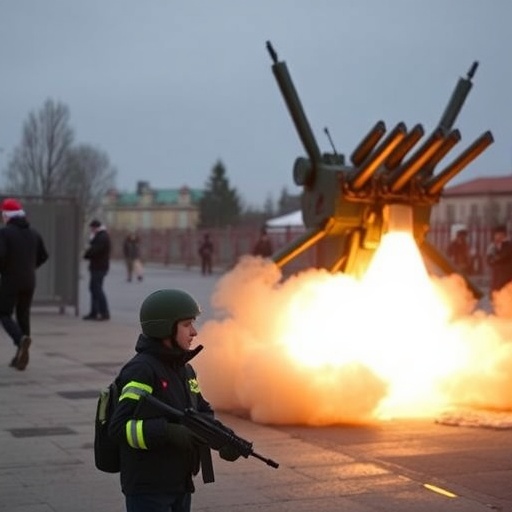Zelensky Demands More Patriot Missiles as Russian Attacks Wound 14 in Kyiv, Including Children
In the shadow of yet another devastating barrage, Ukrainian President Volodymyr Zelensky has issued a stark plea to Western allies: deliver more US-made Patriot air defense systems immediately. The call comes just hours after a massive Russian missile and drone assault on Kyiv early Tuesday morning, which left 14 people injured, including two children, and sent shockwaves through the capital’s residents. As explosions rocked the city skyline, the attack underscored the relentless pressure Ukraine faces in its fight against Russian aggression, with Zelensky emphasizing that without bolstered defenses, more lives hang in the balance.
- Chaos in the Capital: Eyewitness Accounts from Kyiv’s Night of Terror
- Zelensky’s Direct Appeal: Why Patriot Missiles Are Ukraine’s Lifeline
- Escalating Russian Attacks: A Pattern of Intensified Bombardment
- Global Allies Respond: Pledges and Challenges in Arming Ukraine
- Looking Ahead: Ukraine’s Path to Stronger Skies and Sustained Resistance
The assault, one of the most intense on Kyiv in recent months, involved over 40 missiles and drones launched from Russian territory, according to Ukrainian military officials. Air raid sirens wailed through the night, forcing thousands into bomb shelters as interceptors lit up the pre-dawn sky. While Ukraine’s existing defenses managed to down most of the incoming threats, debris from the interceptions rained down on residential areas, causing fires and structural damage. This latest escalation in Russian attacks on Kyiv has not only heightened fears among civilians but also reignited global debates over military aid to Ukraine.
Chaos in the Capital: Eyewitness Accounts from Kyiv’s Night of Terror
As the first missiles streaked toward Kyiv around 3 a.m., residents were jolted awake by the deafening roar of air defenses engaging the threats. “It felt like the end of the world,” said Olena Kovalenko, a 35-year-old mother living in the Solomianskyi district, where several impacts were reported. Her two children, aged 7 and 9, were among the injured, suffering from cuts and bruises after a piece of shrapnel shattered their apartment window. Medical teams at Kyiv’s Okhmatdyt Children’s Hospital treated over a dozen victims, with officials confirming that the injuries ranged from minor lacerations to concussions caused by the concussive blasts.
Ukrainian emergency services reported that the attack targeted critical infrastructure, including power grids and transportation hubs, in a bid to cripple the city’s operations. By dawn, at least five buildings were damaged, and power outages affected thousands of households. The State Emergency Service of Ukraine documented 112 calls related to the incident, with firefighters battling blazes in the Shevchenkivskyi and Podilskyi districts. “These Russian attacks on Kyiv are not just military strikes; they’re assaults on civilian life,” Zelensky stated in a video address posted to social media shortly after the all-clear was given. His words captured the raw emotion rippling through the city, where schools and workplaces remained closed as cleanup efforts began.
Statistics from the Ukrainian Air Force paint a grim picture of the ongoing threat: since the full-scale invasion began in February 2022, Russian forces have launched more than 8,000 missiles and drones at Ukrainian targets, with Kyiv bearing the brunt in over 30% of cases. This particular barrage was the 15th major attack on the capital in 2024 alone, highlighting a pattern of intensified Russian attacks aimed at wearing down Ukraine’s resolve and testing its defensive capabilities.
Zelensky’s Direct Appeal: Why Patriot Missiles Are Ukraine’s Lifeline
Standing amid the rubble of a struck residential block during a morning briefing, President Zelensky did not mince words. “We need more Patriot missiles now—every delay costs Ukrainian lives,” he declared, his voice steady but laced with urgency. Zelensky’s plea is rooted in the proven effectiveness of the Patriot systems, which have been instrumental in shielding Ukrainian skies since their first delivery in 2023. These advanced US-developed batteries, capable of intercepting ballistic missiles and cruise missiles at ranges up to 160 kilometers, have intercepted over 90% of targeted threats in high-stakes engagements, according to Pentagon assessments.
Ukraine currently operates a limited number of Patriot batteries, donated by the United States, Germany, and other NATO allies. However, maintenance demands and the sheer volume of Russian attacks have strained these resources. Zelensky highlighted this in a recent interview with CNN, noting, “One Patriot system saved Kyiv from destruction last winter, but we face waves of attacks that no single battery can handle alone.” His call echoes previous requests, including a November 2023 summit where he urged G7 leaders to commit to long-term defense packages including additional Patriots.
The strategic importance of these systems cannot be overstated. In a conflict where air superiority remains elusive for Ukraine, Patriot missiles provide a critical deterrent against Russian airstrikes that target not just military sites but also hospitals, schools, and energy facilities. Experts from the Institute for the Study of War (ISW) report that without expanded air defenses, Ukraine could see a 40% increase in successful strikes on civilian infrastructure by year’s end, exacerbating the humanitarian crisis.
Escalating Russian Attacks: A Pattern of Intensified Bombardment
The Tuesday assault on Kyiv is part of a broader surge in Russian attacks across Ukraine, with military analysts attributing the uptick to Moscow’s efforts to divert attention from stalled ground offensives in the east. In the past week alone, Russian forces have conducted over 200 drone incursions and missile launches nationwide, according to the Ukrainian General Staff. Donetsk and Kharkiv regions have seen parallel strikes, but Kyiv’s status as the political heart makes it a prime target for psychological warfare.
One notable aspect of this escalation is the use of hypersonic Kinzhal missiles, which challenge even the most advanced defenses. During the Kyiv attack, at least three such missiles were deployed, forcing Ukrainian operators to prioritize intercepts amid a swarm of slower-moving Shahed drones used as decoys. “This tactic is designed to overwhelm our systems,” explained Andriy Yermak, head of the Presidential Office, in a statement to Reuters. The result has been a 25% rise in breakthrough successes for Russian projectiles in urban areas over the last quarter.
Historical context reveals a chilling evolution: early in the war, Russian attacks focused on border regions, but by mid-2023, they had penetrated deep into central Ukraine, including Kyiv. The International Criminal Court has documented over 100 instances of indiscriminate strikes on civilian targets, labeling them potential war crimes. With winter approaching, fears mount that Russian attacks could target heating infrastructure, as seen in last year’s blackouts that left millions without power.
Global Allies Respond: Pledges and Challenges in Arming Ukraine
Zelensky’s urgent request for more Patriot missiles has elicited mixed responses from international partners. The United States, the primary supplier, has already committed $61 billion in aid to Ukraine this year, including two additional Patriot batteries announced in September. However, production bottlenecks at Lockheed Martin, the manufacturer, mean new systems could take up to 18 months to deliver. “We’re ramping up production, but urgency demands creative solutions,” said US Defense Secretary Lloyd Austin during a NATO meeting in Brussels.
European allies are stepping up too. Germany pledged interceptor missiles for existing Patriots last month, while the Netherlands and Romania are exploring joint acquisitions. Yet, political hurdles persist: in the US, congressional debates over aid packages have delayed shipments, with critics arguing for a negotiated end to the conflict. Zelensky addressed this in a UN speech, stating, “Delaying Patriots isn’t just policy—it’s a choice between life and death for Ukrainians.”
Non-governmental organizations like the Atlantic Council emphasize the broader stakes. A recent report notes that bolstering Ukraine’s air defenses could reduce civilian casualties by 60%, freeing up resources for frontline troops. Aid fatigue is real, but events like the Kyiv attack serve as stark reminders of the cost of inaction.
Looking Ahead: Ukraine’s Path to Stronger Skies and Sustained Resistance
As Ukraine braces for what could be a harsh winter of intensified Russian attacks, Zelensky’s push for more Patriot missiles signals a pivotal moment in the war’s trajectory. Enhanced defenses could not only protect Kyiv and other cities but also enable Ukraine to launch counteroffensives, reclaiming initiative in the Donbas region. Military strategists predict that with 10-12 additional batteries, Ukraine could achieve near-total coverage over its western and central territories, drastically curbing Russian air incursions.
Diplomatically, Zelensky plans to raise the issue at upcoming summits, including the NATO summit in Washington next summer. Meanwhile, domestic resilience grows: Ukrainian engineers are adapting Western tech with local innovations, such as drone-jamming add-ons for Patriots. International monitoring groups, including the OSCE, call for increased sanctions on Russian missile producers to starve the aggressor’s arsenal.
The human element remains central. Families like the Kovalenkos embody the stakes, with children returning to school amid lingering fears. As Zelensky rallies his nation, the world watches: will more Patriot missiles arrive in time to shield Ukraine from the storm? The answer could define not just the fate of Kyiv, but the future of European security.
In the days following the attack, volunteer networks in Kyiv distributed aid to affected families, underscoring the community’s unyielding spirit. Reports from the front lines indicate Ukrainian forces downed 80% of the incoming threats, a testament to training provided by NATO allies. Yet, experts warn that without sustained support, the tide could turn. The EU’s recent €50 billion macro-financial package includes provisions for defense tech, potentially accelerating Patriot deliveries through co-production deals.
Broader implications extend to global arms dynamics. Demand for Patriots has surged, with Taiwan and Poland also seeking systems amid rising tensions with China and Russia. This competition could drive innovations in missile defense, benefiting Ukraine indirectly. Domestically, Zelensky’s government is investing in indigenous production, aiming for a hybrid defense network by 2025.
Interviews with Kyiv residents reveal a mix of defiance and exhaustion. “We won’t break, but we need the world to stand with us,” said Petro Symonenko, a retired engineer whose home was damaged. As reconstruction begins, the call for more Patriots echoes louder, a beacon of hope in Ukraine’s protracted struggle.








